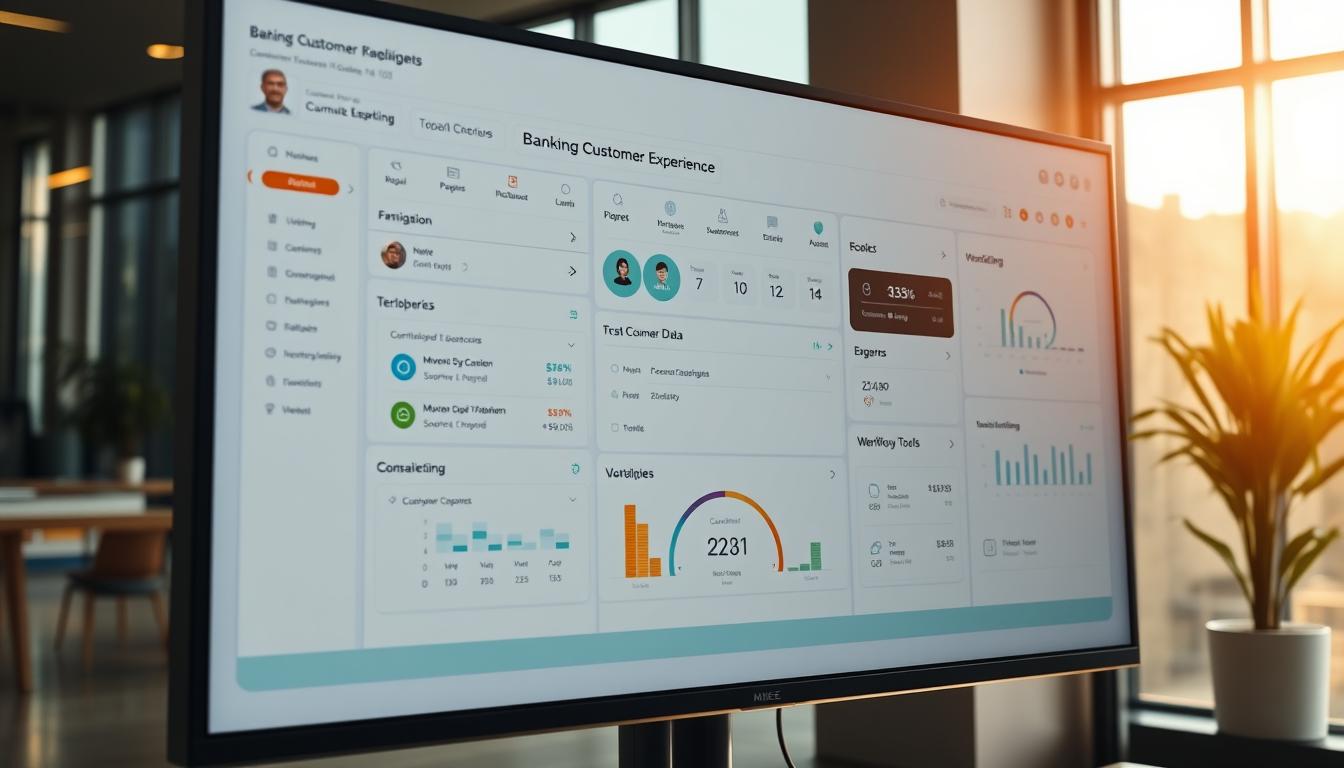In today’s banking world, a huge 70% of customers leave because of bad service. Using a strong CRM solution can change the game. It helps banks keep customer data in one place, make things simpler, and succeed in business.
With CRM software for banks, financial places can change how they talk to customers. They can make things run smoother and make customers happier. This builds loyalty and helps them grow over time.
Key Takeaways
- CRM solutions centralize customer data for personalized experiences.
- Enhanced customer service drives loyalty and retention.
- Streamlined processes improve operational efficiency.
- Data-driven insights inform strategic business decisions.
- Robust CRM implementation supports long-term business growth.
Understanding Customer Relationship Management in Banking
The banking world is turning to Customer Relationship Management (CRM) to better connect with customers and keep them coming back. With more competition and changing customer needs, CRM is key for great customer experiences.
The Importance of CRM in Financial Institutions
CRM is crucial for banks to manage customer relationships well. It helps by keeping all customer data in one place, tracking interactions, and automating tasks. This leads to personalized experiences and keeps customers happy and loyal.
CRM’s role in banking is huge. It helps:
- Boost customer engagement with targeted ads
- Improve service by giving a full view of customer interactions
- Speed up sales by handling customer questions faster
Key Features of CRM Systems for Banking
Good CRM systems for banks have many features for better customer management. Some key ones are:
- Customer Data Management: Keeps all customer info in one spot for a clear view.
- Communication Tracking: Logs all customer interactions, no matter the channel.
- Process Automation: Automates simple tasks to make operations smoother.
- Analytics and Reporting: Offers insights into what customers like and do.
These features help banks understand their customers better and tailor services to their needs.
How CRM Improves Customer Retention
Keeping customers is a big challenge for banks, and CRM helps a lot. It lets banks offer personalized experiences, meet customer needs, and provide top-notch service. This boosts customer retention.
Experts say, “CRM is more than tech; it’s about putting customers first in everything you do.” By using CRM, banks can focus more on customers, leading to more loyalty and retention.
“The right CRM system can help banks build stronger relationships with their customers, driving long-term growth and profitability.”
Benefits of Implementing CRM in Banking
Using CRM in banking brings many benefits that make customer experiences better. It helps banks keep all customer data in one place. This makes sure the information is the same everywhere in the bank.
Streamlining Communication with Customers
CRM systems make it easier for banks to share important info with customers. Efficient communication builds trust and keeps customers loyal. Banks can quickly answer customer questions and worries.
Enhancing Customer Insights and Personalization
CRM gives banks a full view of how customers interact with them. This lets banks tailor their services to what each customer needs. Personalizing services is very important in today’s banking world.
Increasing Operational Efficiency in Banking Processes
CRM makes banking work more efficient by automating simple tasks. This helps banks reduce operational costs and use resources better. Banks can also be more agile and quick to respond to changes in the market.
In summary, CRM in banking has many benefits. It improves how banks talk to customers and makes their work more efficient. By using CRM, banks can really improve how they manage customer relationships.
Choosing the Right CRM Solution for Banks
Choosing a CRM solution for banks is a big decision. Banks want to improve customer service and work more efficiently. The CRM system must fit their specific needs and goals.
Key Considerations When Selecting a CRM
When looking at CRM solutions, banks need to think about a few important things. Integration capabilities are key. The CRM must work well with the bank’s current systems. Scalability is also crucial, making sure the CRM can grow with the bank.
Banks should also look at the CRM’s analytics capabilities. Good analytics give insights into customer behavior. This helps banks make better decisions and create targeted marketing.
Comparison of Popular CRM Platforms for Banking
Many CRM platforms are popular in banking, each with its own strengths. Comparing these platforms helps banks make the best choice.
| CRM Platform | Key Features | Banking Industry Tailoring |
|---|---|---|
| Salesforce Financial Services Cloud | Advanced analytics, customer segmentation, personalized marketing | Specifically designed for financial institutions, offering industry-tailored solutions |
| Creatio | Customizable workflows, omnichannel engagement, AI-driven insights | Flexible and adaptable to various banking needs, with a focus on customer engagement |
| Microsoft Dynamics 365 | Integrated CRM and ERP capabilities, AI-powered customer insights | Offers comprehensive solutions for financial services, with a strong focus on integration |
As shown in the table, each CRM platform has its own benefits. By carefully looking at these options, banks can pick a CRM that improves their customer relationships and grows their business.
Integrating CRM with Existing Banking Systems
CRM solutions are becoming more popular in banking. But, they only work well if they’re integrated with current systems. Good integration is key for smooth information flow and getting the most from CRM.

Challenges of Integration
Integrating CRM with banking systems is tough. One big issue is data migration. Moving customer data from old systems to CRM can be tricky and must be done carefully to avoid losing or messing up data.
Another big challenge is making sure systems work together. Banks often have many old systems. Getting these to talk to the CRM can be hard. Also, change management is important. The integration affects not just tech but also how the bank works and its people.
“The integration of CRM with existing systems is not just a technical challenge; it’s also about aligning the technology with the bank’s overall strategy and customer needs.”
Best Practices for Successful Integration
To beat the challenges of CRM integration, banks should follow some key steps. These steps help make the integration smooth and effective.
- Thorough Planning: A detailed plan is vital. It should cover the scope, timeline, and resources needed.
- Stakeholder Engagement: Getting everyone involved is important. It makes sure everyone knows what’s happening and what they need to do.
- Ongoing Support: Keeping staff trained and supported is key for CRM’s long-term success.
| Best Practice | Description | Benefit |
|---|---|---|
| Thorough Planning | Comprehensive plan outlining scope, timeline, and resources. | Reduces risk of project delays and cost overruns. |
| Stakeholder Engagement | Engaging stakeholders across the organization. | Ensures alignment and understanding among staff. |
| Ongoing Support | Providing support and training to staff. | Ensures long-term success of CRM integration. |
By knowing the challenges and following the best practices, banks can make sure their CRM works well with their systems. This leads to better customer service and more efficient operations.
Utilizing CRM Data for Marketing Strategies
CRM data is changing how banks market themselves. It helps them make better marketing plans. This is thanks to the insights from CRM software for banks.
With CRM data, banks can sort their customers in different ways. They can look at things like what customers buy, what accounts they have, and who they are. This makes it easier to send messages that really speak to each group.
Leveraging Customer Segmentation
Segmenting customers is a key part of banking CRM strategies. It lets banks find out who their most valuable customers are. Then, they can send them special offers.
CRM data also helps banks understand their customers better. By looking at how customers act and what they like, banks can send messages that feel just right. This makes customers more likely to pay attention.
| Segmentation Criteria | Marketing Strategy | Expected Outcome |
|---|---|---|
| Transaction History | Personalized Offers | Increased Customer Engagement |
| Demographic Information | Targeted Advertising | Higher Conversion Rates |
| Account Types | Tailored Financial Products | Improved Customer Satisfaction |
Creating Targeted Campaigns for Financial Products
CRM data helps banks make campaigns that really hit the mark. They look at customer data to find out who might be interested in their products. Then, they craft messages that speak directly to those customers.
For example, a bank might see that someone has just bought a house. Then, they offer them home insurance. This approach not only boosts sales but also makes customers happier because they get offers that fit their needs.
In short, using CRM data is key for banks to get their marketing right. By sorting customers and making campaigns that really speak to them, banks can do a lot better. They can get more out of their marketing efforts.
Training Staff on CRM Usage in Banking
Training staff on CRM systems is key for banks to get the most out of their investment. It helps improve customer retention in banking. A well-trained team can use CRM analytics to offer personalized services, boosting business growth.
Employee Training Importance
Training on CRM is more than just learning software. It’s about improving how staff manages customer relationships. By using CRM data, bank employees can provide custom financial solutions, making customers happier and more loyal.
A CRM for banking solution makes employees more productive by automating tasks. This lets them focus on important, strategic work. For example, a global bank saw better customer engagement after a thorough CRM training program.
Strategies for Effective Training
To make CRM training work, banks should follow these steps:
- Hands-on training sessions to get staff familiar with the CRM system.
- Ongoing support to help with any questions or issues.
- Continuous feedback to check if the training is effective and to find areas to improve.
By using these strategies, banks can make sure their staff knows how to use CRM systems well. This improves customer relationships and boosts business success.

| Training Strategy | Description | Benefits |
|---|---|---|
| Hands-on Training | Practical sessions for staff to learn CRM usage. | Improved proficiency, reduced errors. |
| Ongoing Support | Continuous assistance for staff to overcome challenges. | Enhanced confidence, better CRM utilization. |
| Continuous Feedback | Regular evaluation of training effectiveness. | Identifies areas for improvement, ensures training relevance. |
Case Studies: Successful CRM Implementation in Banks
Many top banks have added CRM solutions to their systems. This has led to better customer insights and more efficient operations. This section will look at a notable example and the results from these implementations.
A Leading U.S. Bank’s CRM Journey
Cornerstone Bank in Massachusetts is a great example of CRM success. They used Creatio with their core banking system. This move helped them keep all customer data in one place and make it easy to access.
This integration allowed the bank to offer services that were more tailored to each customer. This made the customer experience much better.
The CRM at Cornerstone Bank brought big wins. Customer satisfaction and operational efficiency both improved a lot. The bank could use customer data to make better marketing campaigns.
This led to more customers engaging with the bank and staying loyal.
Outcomes and Lessons Learned
The CRM at Cornerstone Bank brought many benefits. These included enhanced customer insights, improved customer service, and increased operational efficiency. The bank could now segment customers better and market more personally.
Important lessons from this success include the need for careful planning, stakeholder engagement, and ongoing support. These were key to the CRM’s success and its benefits.
By using CRM, banks like Cornerstone can greatly improve their customer service and efficiency. As the banking world keeps changing, CRM’s role in bettering customer relationships and business growth will grow too.
The Future of CRM in the Banking Industry
The future of banking is closely tied to CRM technology. CRM solutions for financial institutions will be key in shaping customer experiences and improving operations.
Emerging Trends in CRM Technology
Several trends are set to change CRM in banking. These include:
- Artificial Intelligence (AI) and Machine Learning (ML): They will improve predictive analytics and personalization.
- Cloud Computing: It will bring scalability and flexibility to CRM solutions.
- Omnichannel Engagement: It will ensure seamless customer experiences across all touchpoints.
These trends are more than just tech updates. They mark a big change in how banks interact with customers. With AI and ML, banks can predict what customers need and offer services ahead of time. This will greatly improve customer satisfaction.
Predictions for CRM’s Role in Customer Experience
CRM’s role in customer experience will grow as technology advances. Here are some predictions:
- CRM will become more predictive, helping banks meet customer needs before they arise.
- CRM will integrate with other banking systems, giving a more holistic view of the customer and enabling personalized services.
- CRM will be key in omnichannel engagement, ensuring a smooth experience across all platforms.
The banking CRM software market is expected to grow from $9.5 billion in 2021 to $39.2 billion by 2031. This shows CRM’s growing importance in banking. Looking ahead, CRM will lead in banking innovation, improving both customer satisfaction and operational efficiency.
Measuring the Success of CRM Initiatives
To measure the success of customer relationship management in banking, we track key performance indicators (KPIs). These KPIs show how well our CRM strategies are working. With CRM software for banks, we get insights into what customers like and need.
Key Metrics for Evaluation
We look at customer satisfaction, retention, and sales growth to see if our CRM is effective. These metrics help us understand how our CRM strategies affect customer interactions and business results.
Assessing Customer Feedback
We check customer satisfaction and loyalty by looking at feedback, net promoter scores, and retention rates. By analyzing these, we can improve our CRM to better serve customers and improve their experience.
By regularly checking these KPIs, we make sure our CRM efforts match our business goals. This helps us achieve meaningful results in the banking world.



